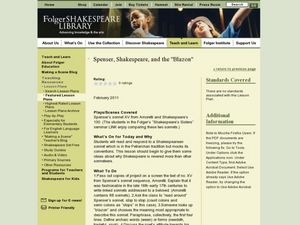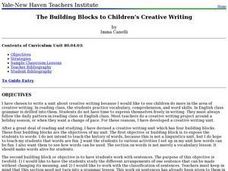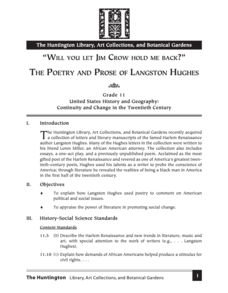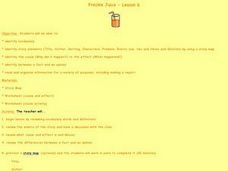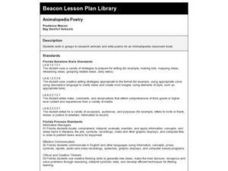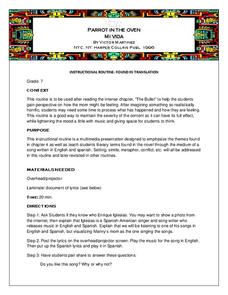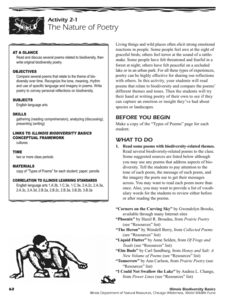Curated OER
Spenser, Shakespeare, and the "Blazon": Lesson 4
Students discuss the meaning and tone of Shakespeare's Sonnet 130. In this sonnets lesson, students compare Spenser's sonnets to Shakespeare's. Students discuss specific words that add to the humor in Shakespeare's sonnet,...
Curated OER
Creative Writing: Children's Building Blocks
Your class can participate in a writing program involving four building blocks. By exploring words, sentences, writing forms, and story organization, they improve their creative writing skills throughout this year-long unit. Early in the...
Curated OER
Hyena: an Edward Morgan Poem
Students read, listen to and analyze the poem The Hyena by Edward Morgan. In this poetry techniques lesson, students explore the visual images of animals and their unpleasant traits. Students answer questions about the animal...
Huntington Library
The Poetry and Prose of Langston Hughes
Eleventh graders discover the poetry of Langston Hughes. In this social issues lesson plan, 11th graders experience the views of Langston Hughes. Students read Hughes' poetry and discuss the basic theme. Students evaluate the political,...
Curated OER
Poetry in Music
Sixth graders look at poetry in music. In this language arts lesson, 6th graders listen to and read the lyrics of songs to find the poetic aspects of them. They focus on similes and metaphors and write their own songs lyrics.
Curated OER
Introducing Literary Elements in Fiction
Identify literary elements in fiction. In this reading comprehension lesson, learners read the book Pigsty and record literary elements onto a graphic organizer. They specifically discuss the main characters and events in the text.
Curated OER
Freckle Juice- Lesson 6
Students read Freckle Juice. In this comprehension instructional activity, students complete a story map and discuss cause and effect based on readings from Freckle Juice.
Curated OER
Paradise Lost: Concept Analysis
New to using Paradise Lost in your classroom? Here's a packet that provides background information, lists of research projects, and enrichment resources. A great addition to your curriculum file.
Curated OER
Animalopedia Poetry
Students reseach animals while working in groups. They write poems to be included in a class Animalopedia book.
Curated OER
Reflections on Poetry Readings
Eighth graders design and compile a booklet of published and original poems reflective of a specific theme.
Curated OER
Observation And Listening Skills
First graders read a story about polar bears and make observations as they read. In this observations lesson plan, 1st graders listen carefully and sing a bear chant.
Missouri Department of Elementary
Feeling Faces
A activity help scholars identify emotions through facial expressions. After a friendly puppet reads scholars a poem all about feelings, learners act out how they would feel when a specific action happens to them. Participants watch and...
Rainforest Alliance
Sounds of the Rainforest
Do you hear what I hear? Encourage scholars to use their listening skills and participate in a series of activities that demonstrate how the sense of hearing is crucial to the human and animal world. Activities guide learners...
Curated OER
Parrot in the Oven: Instructional Routine
After reading "The Bullet," a particularly intense chapter in Victor Martinez's Parrot in the Oven: Mi Vida, class members listen to the Spanish and the English versions of "Dimelo" by Enrique Iglesias. They then discuss how the...
Curated OER
We’re Going on a Bear Hunt
Second graders participate in guided reading and writing experience in this set of five lessons. They complete a picture walk of Michael Rosen's, We're Going on a Bear Hunt before listening to the story and retelling it. Working with a...
Curated OER
Create a Computer Story
Second graders will create their own story and read it aloud. In this literacy/technology lesson, 2nd graders use computer software to create their own story, which is read back to them while they write it. Afterward, the student should...
Curated OER
Art and Literacy, grades 3-6, Reading Comprehension Category: Critical Stance
Students compare two very different works of art and two poems, and verbally list similarities and differences they perceive in the works of art and the poems; students then select poem that best correlates with a work of art.
Curated OER
Poetry on the Web
Eighth graders search a website and locate a poem written by a specific poet whose work appears in the grade 8 anthology. After listening to poetry, 8th graders present oral or written examples of imagery and an analysis of the imagery.
Curated OER
Up, Up, Up The Banana Tree
Students increase their reading fluency through the use of various strategies. After reviewing decoding, chunking and rereading, students complete an initial read of a novel text. Working with a partner, they read complete a timed...
Curated OER
Through the Odyssey, Lesson 1:
Ninth graders continue to make their way through "The Odyssey". Using the text, they take notes, write a short informational paper and present it to the class. They answer reading comprehension questions to end the lesson.
Illinois Department of Natural Resources
Section Two: Why is Biodiversity Important?
Explore soil, genetic traits, natural resources, and pollution in a series of lessons that focus on biodiversity. Kids complete experiments to learn more about the importance of varied genes and organisms in an ecosystem.
Curated OER
Theology…the Use of Silence in the Classroom
Immerse your class in the Middle Ages with a thorough history lesson. After viewing examples of illuminated manuscripts such as the Book of Kells, they discuss how these were the mode of keeping and storing information...
Curated OER
Skellig
In this Skellig worksheet, students read to understand the works of David Almond and learn about his life. Students read eleven passages and then answer ten questions related to reading for meaning and understanding the author's craft.
Curated OER
Geo Jammin' - Day 2, Lesson 6: Rhyme and Reason
Students listen to the poem "Shapes" by Shel Silverstein in order to accurately and specifically describe shapes' rules/traits in their journals. They illustrate the poem and take turns reading during a creative shared reading session.
